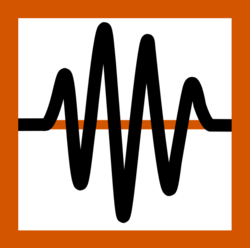Software:Sonic Visualiser
 | |
| Developer(s) | Centre for Digital Music at Queen Mary, University of London |
|---|---|
| Written in | C++ |
| Operating system | Linux, MacOS, Windows |
| Type | Audio analysis |
| License | GPL-2.0-or-later[1] |
| Website | www |
Sonic Visualiser is an application for viewing and analysing the contents of music audio files. It is a free software distributed under the GPL-2.0-or-later licence.[2]
History
Sonic Visualiser was developed at the Queen Mary University of London's Centre for Digital Music in 2007. It was written in C++ with Qt and released under the terms of the GNU GPL.[2]
Overview
Sonic Visualiser represents acoustic features of the audio file either as a waveform or as a spectrogram.[3] Spectrogram is a heatmap, where horizontal axis represents time, vertical axis represents frequency, and the colors show presence of frequencies. Sharpness and smoothness of the spectrogram can be configured.[4] There are three types of spectrogram:
- generic spectrogram
- melodic-range spectrogram
- peak-frequency spectrogram
Generic spectrogram covers the full frequency range and uses linear frequency scale. Melodic-range spectrogram covers the range which usually contains musical detail. Peak-frequency spectrogram performs phase difference calculations and estimates exact frequencies at each peak cell.[2]
The interface consists of panes and layers. Panes allow to display multiple visualisations simultaneously, and they get aligned in the time axis. A pane can have multiple layers which are used for annotation.[2] The user can configure color schemes for layers, and they can be navigated by clicking the labeled tabs.[4]
There are multiple types of annotation layers which can be edited, including time instants, time-value plots, labels and images. Time instants do not have any associated value, and they can be used to annotate points (e.g. beat locations).[2] Annotations allow the user to clarify relationships between musical parameters.[3]
Sonic Visualiser supports third-party plugins in the Vamp plugin format. The plugins take audio input and parameters and return values for display.[2] There are plugins which compute spectral flux and spectral centroid. Other plugins include automatic melody extraction, beat finding, chord analysis, etc.[4]
Sonic Visualiser is available for Linux, OS X, and Windows operating systems.[2]
See also
References
- ↑ "Sonic Visualiser license". Archived from the original on 2021-05-09. https://web.archive.org/web/20210509202550/https://www.sonicvisualiser.org/download.html.
- ↑ 2.0 2.1 2.2 2.3 2.4 2.5 2.6 Cannam, Chris; Landone, Christian; Sandler, Mark (October 2010). "Sonic Visualiser: An Open Source Application for Viewing, Analysing, and Annotating Music Audio Files". Proceedings of the 18th ACM international conference on Multimedia. doi:10.1145/1873951.1874248. https://sonicvisualiser.org/sv2010.pdf. Retrieved January 18, 2024.
- ↑ 3.0 3.1 Dolan, David; Slaboda, John; Jensen, Henrik Jeldtoft; Cruts, Bjorn; Feygelson, Eugene (2013). "The improvisatory approach to classical music performance: an empirical investigation into its characteristics and impact". Music Performance Research 6. https://www.gsmd.ac.uk/sites/default/files/2022-05/The%20improvosatory%20approach%20to%20classical%20music%20performance-2013-accessible.pdf. Retrieved January 19, 2024.
- ↑ 4.0 4.1 4.2 Thompson, Marc R. (December 1, 2021). "Sonic Visualiser: Visualisation, Analysis, and Annotation of Music Audio Recordings". Journal of the American Musicological Society 74 (3). doi:10.1525/jams.2021.74.3.701. https://online.ucpress.edu/jams/article/74/3/701/119252/Sonic-Visualiser-Visualisation-Analysis-and. Retrieved January 20, 2024.
External links
- Changelog / Release Notes
- Community and Developer Resources
- Documentation for version 3.1.1
- Screenshots
- Videos
 |



